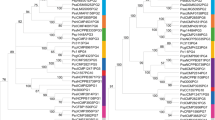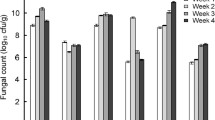Abstract
In order to understand the mode of action of taxonomically related Pseudomonas syringae pathovar strains that infect pea, tomato, and soya bean, we examined their extracellular polysaccharides (EPS). Maximum production of polysaccharide in shake culture of these pathogens was observed between 24 and 60 h. P. syringae pv. pisi 519, the bacterial blight pathogen of pea, produced a higher amount of polysaccharide (34.87 μg/mL) at 60 h compared with 32.67 μg/mL produced by P. syringae pv. glycinea NCPPB 1783, the bacterial blight pathogen of soya bean, and 30.03 μg/mL produced by P. syringae pv. tomato NCPPB 269, the bacterial speck pathogen of tomato. EPS produced by P. syringae pv. pisi 519, P. syringae pv. tomato NCPPB 269, and P. syringae pv. glycinea NCPPB 1783 was characterized with infrared (FTIR), nuclear magnetic resonance (NMR), high performance thin layer chromatography, (HPTLC), and matrix-assisted laser desorption/ionization time-of-flight (MALDI-TOF) mass spectrometry. HPTLC profiles revealed the presence of glucose and glucuronic acid in all bacteria and mannose only in P. syringae pv. tomato. Molecular mass of EPS of P. syringae pv. pisi (m/z 933.8), P. syringae pv. tomato (m/z 950.4), and P. syringae pv. glycinea (m/z 933.5) was confirmed by MALDI-TOF mass spectrometry.
Similar content being viewed by others
Author information
Authors and Affiliations
Rights and permissions
About this article
Cite this article
Datta, ., Kumar, ., Ayyadurai, . et al. Polysaccharides of Pseudomonas Pathovar Strains That Infect Pea, Tomato, and Soya Bean. Curr Microbiol 49, 35–41 (2004). https://doi.org/10.1007/s00284-004-4252-4
Issue Date:
DOI: https://doi.org/10.1007/s00284-004-4252-4




